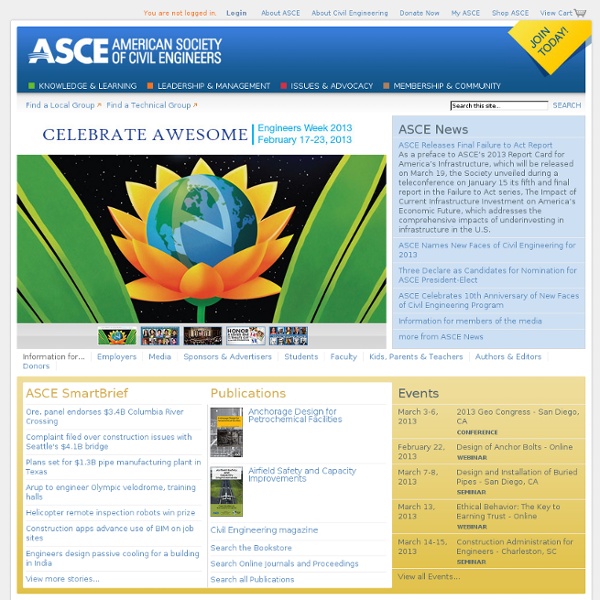



Energy4me | Essential Energy Education: issues, careers, classroom resources iCivilEngineer.com - The Civil Engineering Portal IUE > IWWG > Welcome It is my pleasure to welcome you on the website of the International Waste Working Group, IWWG. The IWWG was set up in 2002 to serve as a forum for the scientific and professional community and to respond to a need for the international promotion and dissemination of new developments in the waste management industry. Today, we are providing an intellectual platform to encourage and support integrated and sustainable waste management and promote practical scientific development in the field. Conceived as a think-tank, whose work is based on scientific principles oriented towards practical applications, the underlying structure of the IWWG enables it focus on a wide range of subjects, to react promptly to problems that arise in the field, and to communicate effectively within the professional community. The following webpages provide an overview on our structure, activities and outcomes. Welcome again and I am looking forward to meeting you at one of our future events.
ACEC New York - Home Ingeniería y Construcción Miliarium.com, Ingeniería Civil, Construcción y Medio Ambiente Bienvenidos a ACI PERU - Capítulo Peruano del American Concrete Institute Concurrencia masiva a Seminario ACI PERU - 8 Marzo 2014 ACI PERU inicio con gran éxito sus actividades para este año 2014. El Seminario de Actualización:... Seminario de actualización ACI PERU - Análisis y diseño de Puentes de concreto armado El Seminario ha sido solicitado por muchos profesionales del medio, y tiene como objetivo: Proporcio... I Ciclo de Conferencias 2013 - ACI USMP IMPORTANCIA DE LA OPTIMIZACIÓN PARA LA CONSTRUCCIÓN SUSTENTABLE FECHA Y HORA: Lunes 27 Mayo 201312... I Concurso Interno Estudiantil ACI-USMP 2013 Con el objetivo de propiciar la participación estudiantil en sus actividades y eventos, estimulando ... Resultados XI Concurso Nacional Estudiantil 2012 ACI PERU Durante la XI Convención Internacional de ACI PERU, llevada a cabo los días 15 y 16 Noviembre del 20... « Previous ‹ Playback Stop Play › Next »
Todo Arquitectura : El portal de Arquitectura, Ingeniería, Diseño y Construcción Building Owners Driving BIM — The Letterman Digital Arts Center Story: AECbytes "Building the Future" Article AECbytes "Building the Future" Article (September 30, 2006) Mieczyslaw (Mitch) Boryslawski, Associate AIA Founder, View By View, Inc. Our world has changed, our economy has changed, and so has the design and construction industry. Building owners are pioneering this rediscovered technology, commonly referred to as building information modeling, or BIM. Overview of the Letterman Digital Arts Center Project The Letterman Digital Arts Center (LDAC) is intended to be the world's premier digital arts center, with cutting-edge special effects production suites and video game development. Figure 1. The LDAC needed a staggering amount of technology to simulate a "virtual movie set," that would allow the employees to share files simultaneously on the different screens from different parts of the buildings. The BIM Process in the LDAC Figure 2. Figure 3. The building information model was updated on a weekly basis and posted to the server. Figure 4. Figure 5. Figure 6. Figure 7. Figure 8. Figure 9.
Emerging Construction Technologies The purpose of this sites is to present Emerging Construction Technologies that could produce a "High Impact" in the construction industry. The technologies are divided into five areas: Civil, Mechanical, Internet-based, Electrical, and Other. Each technology is presented in fact sheets describing: The Need, The Technology, The Benefits, Status, Barriers, Points of Contact, and References. This site should be viewed with Microsoft's Internet Explorer 5.0 or higher. Please click on the link to access the academic breakthroughs portal "Academic Breakthroughs" Purdue ECT website starts the Blog feature (08/07/2008) - A new feature allowing visitors to comment on individual factsheets has been added to the ECT website. Purdue ECT invites new Review Experts (08/05/2008) - Purdue ECT team is in the process of updating its review committee experts and sent out a request to all its members to signup as a review expert.
Sweet Home 3D - Draw floor plans and arrange furniture freely Civil and Environmental Engineering